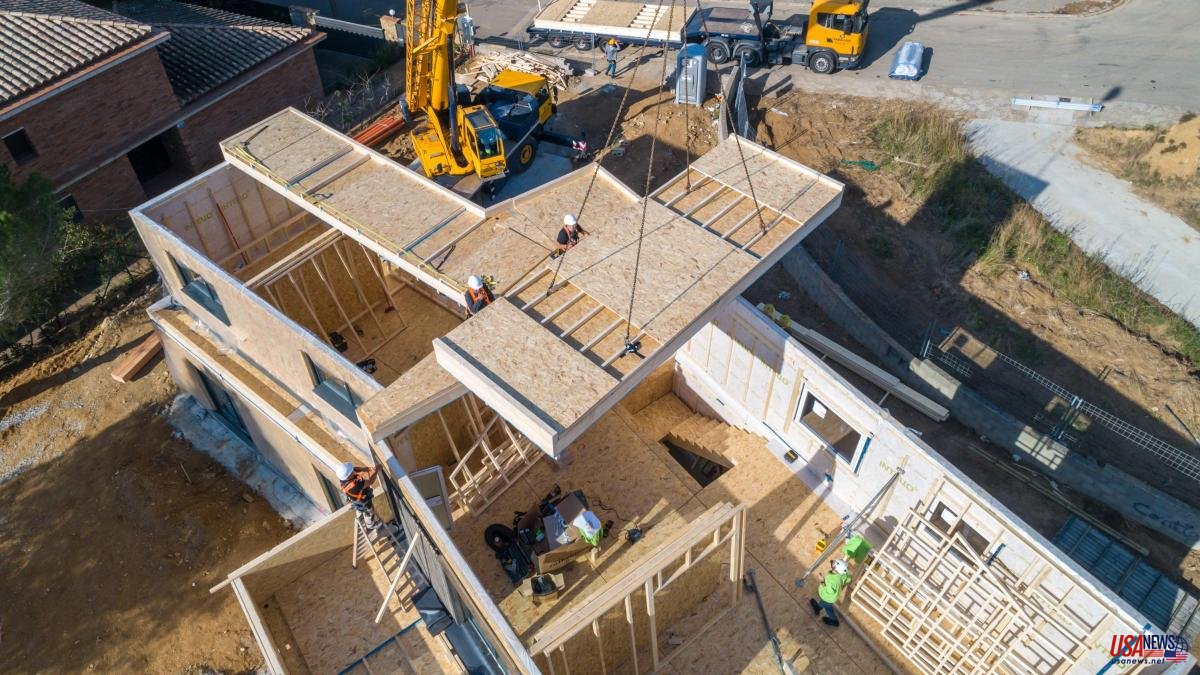The prefabricated house sector is experiencing an unprecedented boom, in which manufacturers cannot accept new orders because they do not have the capacity to build them. The sector has been fueled by the desire to live in larger, more open-plan homes brought about by the pandemic, which has increased single-family home sales. And because the traditional construction sector lives on the edge, with few companies, material supply problems and little labor.
"Every time we have more orders and from clients with greater purchasing power," says José Antonio González, general director of Arquima, a company specializing in passive houses, with wooden structures, which offers its clients turnkey projects: they only need to buy the plot. His average project, of houses of about 180 m2 with a garden and swimming pool, is around 400,000 euros.
González, who prefers to call them “industrialized houses”, explains that his company has an architecture team that designs the houses together with the client. In the workshop they manufacture flat, two-dimensional, custom-made pieces (an average house takes about seven days) and then they assemble and personalize it on the site, in a process that lasts three or four months.
Other companies, on the other hand, offer a catalog of buildings and customize the finishes. This is the case of MiniCasasBarcelona, a company whose basic product is houses of 60 m2 in 60 days for 60,000 euros, plus VAT, but which sells houses from 45 m2.
Agustín Góngora, co-founder and project manager, explains that “our clients want something easy and fast”, and the company is also in charge of carrying out the project and all the paperwork. "We are architects and we guarantee that everything will comply with the regulations and there will be no problems," says Góngora.
At the other extreme, some companies offer container-based houses, with prices of around 25,000 euros for 30 m2 with minimal guarantees of habitability. Here it is the owner who has to be responsible for carrying out all the procedures – at least an architect will need to oversee the project – and bear the costs of conditioning the land and the connections with the supplies. When the manufacturer is an international company, in addition, it will surely have to adapt some elements because they rarely comply with all Spanish building regulations.
Francisco Diéguez, general director of the Institute of Construction Technology (Itec) recalls that prefabricated elements have played an important role in the construction of single-family homes for years, although initially the material used was concrete. This is the case of Hormipresa, doyen of the sector with 50 years behind it, which offers nine housing models from 300,000 euros.
In recent years, however, prefabricated houses have successfully opted for sustainability. "Our flag is bioconstruction," says González. “In Arquima the structures are made of certified wood, and we take care of the hermeticity, the roofs, the air conditioning, with the use of home automation and solar panels. Everything to make passive houses, with minimal energy consumption and healthier due to the materials and air quality. We are not cheap: the cost would be equivalent to a built-in home. But more and more people are willing to pay the price of living like this.”
Arquima, which currently has the capacity to manufacture around 40 homes a year, is expanding its factory to make 150. Last year it had a turnover of 6 million euros and expects to close this year with 9 million revenues, which will rise to around 22 million when the new plant is already running.
MiniCasasBarcelona, for its part, will enter 300,000 euros this year, its first full year, and already has closed projects worth 1 million euros for next year.
Prefabs had been viewed with suspicion for many years as synonymous with low quality. With technological advances and new materials that has changed. At Arquima, González points out, the client chooses the internal and external coverings of the wooden structure from all kinds of materials, so that it has an appearance like that of any home. At MiniCasasBarcelona, for its part, "we don't have a sales office but we send our potential clients to visit a home that has already been built so that they can see it and step on it and find out what we can do."
The prefabricated, on the other hand, have ended up gaining the appreciation of the architects, who initially feared that it would lead to a depersonalizing homogenization. "There are many systems of industrialization -Diéguez points out-. Some are open, and allow the architect to take elements from various manufacturers (bathrooms, enclosures, facades, floors...). In addition, there are modular systems, in which pieces arrive at the construction site that are assembled like a Lego and that greatly define the appearance of the home. But other systems manufacture flat pieces, in 2D, that when assembled on the site allow infinite combinations. Now there are also new ways of personalization with 3D printing techniques, with which different parts can be manufactured for each building”, he adds. It's all about budget, obviously. "We have not yet built two identical houses," says González.
Customers also love the promise of speed. "Whoever orders us an order in six months has the keys to a completely custom-made house, and most of that period is dedicated to managing permits and licenses," González points out. On the other hand, if he makes it out of brick, he will have to wait at least a year and a half to be able to move in”.













